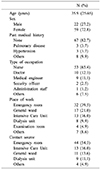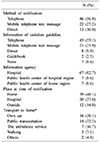Abstract
Background
The purpose of this study was to identify the degree of home isolation and to determine what is needed for an effective home isolation through experience with home isolation that has been found to be in close contact persons with MERS-confirmed patient.
Methods
We conducted a questionnaire survey of employees at a university hospital in Seoul, Korea, which were classified as close contact with the MERS patient who visited the emergency room in June 2015. The questionnaire items were prepared by referring to the MERS response guideline, 3-3 edition.
Results
There were 81respondents in total. At the time of home isolation notification, 74 (91.4%) were guided by the instructions. At the time of home isolation notification, 42 (51.9%) persons were out of the home. When they comed back home, 7 (16.7%) persons were ambulanced-supported, but 14 (33.3%) used public transportation. the performance of “keeping inside home” was 4.51 out of 5, and the perfomance of “twice daily monitoring” was 3.68 out of 5.
Conclusion
As the result of survey suggests, overall isolation practices were satisfactory, but there were difficulties in home isolation practices such as the supply of daily necessities, monitoring of symptom manifestations, and worries about family infections. Therefore, it is advisable to fix the home isolation problems in tandem with the isolation of facilities.
References
1. Sim KY, Kim JH, Lee HC, Kim CT. Influencing factors of prevention practices against infection exposure among emergency medical technicians in emergency rooms. Korean J Emerg Med Serv. 2018; 22:21–34.
2. Lee KH. [Emergency medical services in response to the middle east respiratory syndrome outbreak in Korea]. J Korean Med Assoc. 2015; 58:611–616.

3. Korea Centers for Disease Control and Prevention (KCDC). 2015 Response guideline for MERS ver. 3-3. Updated on 7 June 2015. http://www.cdc.go.kr/CDC/cms/content/mobile/96/63696_view.html.
4. Oh MD. The Korean Middle East Respiratory Syndrome coronavirus outbreak and our responsibility to the global scientific community. Infect Chemother. 2016; 48:145–146.

5. Jeong H, Yim HW, Song YJ, Ki M, Min JA, Cho J, et al. Mental health status of people isolated due to Middle East Respiratory Syndrome. Epidemiol Health. 2016; 38:e2016048.

6. Kim HJ, Yim KM, Hwang JY, Seong SJ, Park JW, Son KH, et al. Difference of psychiatric symptoms of quarantined health care workers according to quarantining method after contacting a Middle East Respiratory Syndrome patient. J Korean Assoc Soc Psychiatry. 2016; 21:63–69.
7. Ha JY, Ban SH. Home isolation experience of the people exposed to Middle East Respiratory Syndrome positive patients. J Qual Res. 2017; 18:34–48.

8. Zaki AM, van Boheemen S, Bestebroer TM, Osterhaus AD, Fouchier RA. Isolation of a novel coronavirus from a man with pneumonia in Saudi Arabia. N Engl J Med. 2012; 367:1814–1820.

9. World Health Organization. Middle East respiratory syndrome coronavirus (MERS-CoV). Updated on 10 July 2018. http://who.int/emergencies/mers-cov/en/.
10. Lee JY, Kim YJ, Chung EH, Kim DW, Jeong I, Kim Y, et al. The clinical and virological features of the first imported case causing MERS-CoV outbreak in South Korea, 2015. BMC Infect Dis. 2017; 17:498.

11. Park YS, Lee C, Kim KM, Kim SW, Lee KJ, Ahn J, et al. The first case of the 2015 Korean Middle East Respiratory Syndrome outbreak. Epidemiol Health. 2015; 37:e2015049.

12. Korea Centers for Disease Control and Prevention. Middle East Respiratory Syndrome coronavirus outbreak in the Republic of Korea, 2015. Osong Public Health Res Perspect. 2015; 6:269–278.
13. Korea Centers for Disease Control and Prevention (KCDC). Response guideline for MERS ver. 5-1. Updated on 2 July 2018. http://www.cdc.go.kr/CDC/cms/content/mobile/48/123048_view.html.




 PDF
PDF ePub
ePub Citation
Citation Print
Print







 XML Download
XML Download